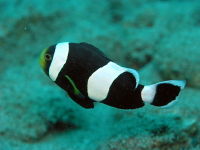Difference between revisions of "Amphiprion polymnus"
From The Aquarium Wiki
m |
|||
| Line 36: | Line 36: | ||
|max_water_hardness=12 | |max_water_hardness=12 | ||
}} | }} | ||
| − | + | ||
| − | + | == Origin == | |
| − | + | :Pacific ocean | |
| − | + | ||
| − | + | ||
| − | + | == Sexing == | |
| − | + | :Hard to do, as males are the same size as females | |
| − | + | ||
| − | + | ||
| − | + | == Tank compatibility == | |
| + | :Peaceful | ||
| + | |||
| + | |||
| + | == Diet == | ||
| + | :Will take most kinds of marine food including live foods such as [[krill]] and flake. | ||
| + | |||
| + | |||
| + | == Feeding regime == | ||
| + | :Daily | ||
| + | |||
| + | |||
| + | == Environment specifics == | ||
| + | :A spacious tank with hiding places is required. Known to host ''[[Stichodactyla haddoni]]'' or ''[[Heteractis crispa]]'' anemones. | ||
| + | |||
| + | |||
| + | == Behaviour == | ||
| + | :Mixes well with nonagressive species | ||
| + | |||
| + | |||
| + | == Identification == | ||
| + | :Typical oval [[:Category:Clownfish|Clownfish]] shape. The Saddleback Clownfish has an orange-brown body with a vertical white band behind its head, and a large white patch on its dorsal area which resembles a "saddle". The colouration can vary from orange to black. The pattern of white bars can also vary. A captive-bred variant was developed that lacked the distinctive "saddle" patch is called the "black saddleback clownfish". | ||
| + | |||
| + | |||
{{Categories | {{Categories | ||
|Category=Fish, Fish (Saltwater), Clownfish | |Category=Fish, Fish (Saltwater), Clownfish | ||
Revision as of 03:17, 13 December 2017
Amphiprion polymnus
114 Litres (30 US G.)
12-13 cm (4.7-5.1")
8.1 - 8.5
22.2-25.6°C (72 -78 °F)
8-12 °d
1:1 M:F
2-5 years
Family
Pomacentridae
This animal is available captive bred
| You can contribute to the Aquarium Wiki by expanding this article. Dont be shy!. |
Contents
Additional names
- Twobanded Anemonefish, Saddleback Clownfish, Brown Saddle Clownfish, Panda Clownfish, White-Tipped Anemonefish, Yellow-Finned Anemonefish
Additional scientific names
- Amphiprion bifasciatus, Amphiprion bifasciatus annamensis, Amphiprion intermedius, Amphiprion laticlavius, Amphiprion polynemus, Amphiprion trifasciatus, Amphiprion polymus
Origin
- Pacific ocean
Sexing
- Hard to do, as males are the same size as females
Tank compatibility
- Peaceful
Diet
- Will take most kinds of marine food including live foods such as krill and flake.
Feeding regime
- Daily
Environment specifics
- A spacious tank with hiding places is required. Known to host Stichodactyla haddoni or Heteractis crispa anemones.
Behaviour
- Mixes well with nonagressive species
Identification
- Typical oval Clownfish shape. The Saddleback Clownfish has an orange-brown body with a vertical white band behind its head, and a large white patch on its dorsal area which resembles a "saddle". The colouration can vary from orange to black. The pattern of white bars can also vary. A captive-bred variant was developed that lacked the distinctive "saddle" patch is called the "black saddleback clownfish".
Pictures
External links
- Fishbase (Mirrors:
 )
)
